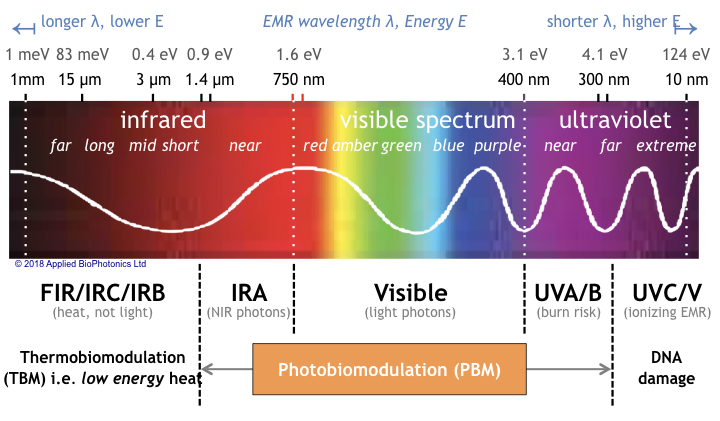Unknown Facts About Photobiomodulation
Wiki Article
Photobiomodulation Can Be Fun For Everyone
Table of ContentsThe smart Trick of Photobiomodulation That Nobody is Talking AboutThe Definitive Guide for PhotobiomodulationOur Photobiomodulation StatementsSome Known Facts About Photobiomodulation.
Laser treatment is a medical therapy that uses concentrated light to promote a process called. During PBM, photons get in the tissue and connect with the cytochrome c complicated within mitochondria. This communication sets off an organic waterfall of events that brings about an increase in mobile metabolic process, which can along with accelerate the recovery procedure.There is consensus that the application of a healing dose of light to damaged or useless tissue causes a mobile reaction moderated by mitochondrial devices. Photobiomodulation. Studies have revealed that these adjustments can impact discomfort and swelling, as well as, tissue repair service
Modifications in ATP, responsive oxygen types and nitric oxide adhere to light absorption by Cc, O. These effects are redox state and dose dependent.

Not known Details About Photobiomodulation
PBM gadgets have been cleared for marketing by FDA with the Premarket Notification/510( k) process as adjunctive devices for the temporary relief of pain. These clearances were based upon the presentation of scientific information to sustain such cases (Photobiomodulation). In this therapy, a light is positioned near or in call with the skin, permitting the light power (photons) to penetrate cells where it engages with chromophores found in cells leading to photophysical and photochemical changes that cause alterations at the molecular, mobile and cells levels of the bodyRemarkably, current research suggests that light can boost performance in typical cells and cells. The potential applications of PBMT are many and are being explored experimentally at the fundamental scientific research, pre-clinical and medical degree. The existing medical usages are for the relief of pain and swelling and the therapy of sports injuries.

The treatment parameters and variety of sessions required for PBMT depend on place and reason. PBMT typically needs greater than one therapy for optimum pain relief. It might take numerous therapies for the outcomes to end up being apparent. reports that it can take anywhere from eight to 30 sessions for a therapy to be totally efficient, and some clients find it necessary to undertake therapy 2 to four times per week.
3 Simple Techniques For Photobiomodulation
Therapy parameters for PBMT were initially developed utilizing cells artificial insemination and in little animal designs. These therapy criteria usually had a reduced irradiance and fluence and functioned well for cutaneous applications. However when clinicians started to make use of PBMT to deal with structures that lay deeper in the body, they utilized these criteria with adverse outcomes.
We currently understand that these negative studies was because of wrong tool and therapy criteria for transcutaneous therapy of deeper structures. Recent breakthroughs in laser therapy devices and more research study into the suitable dosages have actually drastically enhanced the results of PBMT. For dealing with deep tissues, the wavelength of light used figures out the deepness of penetration into a tissue.
It is vital that a clinician makes use of the proper wavelength of light and parameters to deal with a condition. One wavelength and one collection of treatment criteria will not be reliable for all conditions. Negative side impacts see have not been reported from the usage of PBMT.
The Greatest Guide To Photobiomodulation
In the initial experiment, Dr. Endre Mester, used shaved rats and observing just how the laser influenced their capacity to grow hair compared to the group her response that was not obtaining LLLT. He found that the group of mice obtaining LLLT were able to grow their hair back extra rapidly than the team of computer mice that didn't receive LLLT (Hoon C, et al; 2012).This treatment is labelled by doing this to set apart the difference between the lasers some careers utilize to cut (eg. in surgical procedures, or dental treatments). Low-level light therapy is painless, non-invasive treatment. It is utilized to decrease swelling, swelling, and persistent joint conditions, reduce pain and accelerate wound healing of nerves and cells (Hoon C, et al; 2012).
LLLT has a biphasic response, indicating that reduced dosages are generally seen to be a lot more useful than greater doses. That being said, dosages greater or reduced than the optimal dosage does not affect (Hoon C, et al; 2012). Therefore, it can be challenging to have researches on LLLT with many criteria.
Some firms combined both (LED and laser) to offer a much more all-round therapy since lasers can pass through much deeper than LED and infrared light (Norman Doidge, The Mind's Way of Recovery, 2015). During treatment, the area that is being dealt with is revealed to LED light from a Bio, Flex Laser, which goes to 660 nm wavelength, see page adhered to by infrared light at 830-840 nm wavelength.
Report this wiki page